 |
|
Returning from the
greens of the golf course to the greens of his artist's pallet,
Cliff continued to work on the Bonds. The next one up was
Thunderball. I asked Cliff what his involvement was on film?
“Not a lot really. One small bit I remember was that Frank George
had made a model of the Vulcan aircraft, which was to crash land
into the sea. Well, they shot it and unfortunately it looked like a
model. So we were called in to optically put on a load of spray off
the back edges of the wings to give it more of an impression of
power.” |
|
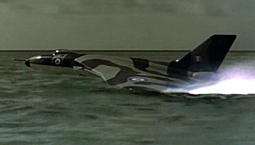 |
|
|
Cliff apologised
that he couldn’t remember more about his work on that particular
film and put it down to old age. I don’t think that age has much to
do with it. When you’ve worked on as many films as Cliff has it must
be difficult to remember what you did on everyone, even if they were
Bond films. One thing Cliff did remember was once again how much fun
it was to work on the Bond films… apart from one.
“You Only Live Twice was a bit of a nightmare. I was involved
with all the volcano stuff. The crew did a lot of location shooting
in Japan of volcanoes, but of course none of them had the opening at
the top or a helicopter pad. So they were all opticals. We printed
in all the shots of the doors opening and looking down into that
huge wonderful Ken Adam set.” |
|
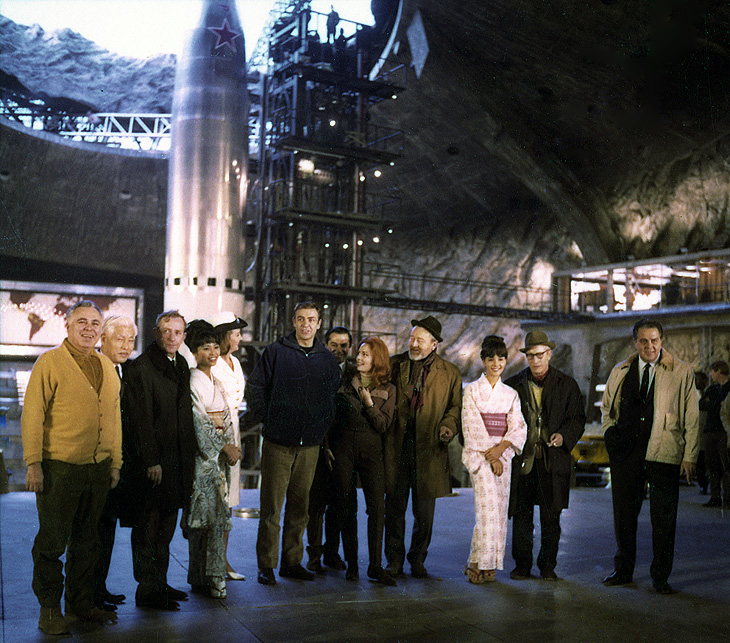 |
|
ABOVE: The cast
and crew of You Only Live Twice (1967) assemble on
Ken Adam’s magnificent volcano set at Pinewood Studios. (L-R)
Producer Harry Saltzman, Teru Shimada (Osato), Director Lewis
Gilbert, Akiko Wakabayashi (Aki), Lois Maxwell (Moneypenny),
Sean Connery (James Bond), Production Designer Ken Adam, Karin
Dor (Helga Brandt), Jan Werich (the original Ernst Stavro
Blofeld), Mie Hama (Kissy), Director of Photography Freddie
Young & Producer Albert R. Broccoli.
BELOW: : Cliff Culley’s matte painting with model spacecraft
descending into the volcano crater. [ROLLOVER] The full
painting. |
|
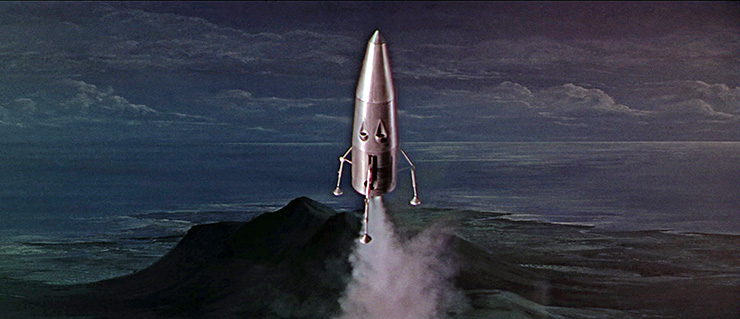 |
|
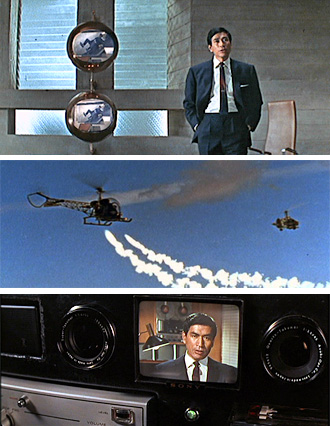 |
|
Examples
of Cliff Culley's opticals in You Only Live Twice. |
|
|
|
Cliff’s nightmare
returns as he points out that to get that type of shot one needed to
be quite high up.
“The cameraman and I were positioned precariously on top of a Savoy
crane, 150 feet above the set floor. Freddie Young was the director
of photography on this one, but he didn’t come up. He used to get on
the radio and ask, ‘What’s it look like fellas?’’ We’d
nervously call back, ‘Fine, fine’ and that kept him happy.”
The crane was used to hoist the helicopter up and down into the set.
A simple operation on the face of it, but there was much more to it
then that.
“It was quite dangerous really,” says Cliff. “When that helicopter
came out of the volcano the crane driver didn’t have much more than
four feet to spare either side of the rotors. Then, when it cleared
the opening of the volcano, there was more turbulence outside the
set then inside and there was quite a bit of swaying about on that
crane. It took a bit of doing I can tell you. In fact I swear that
was where I developed the good grip on my right hand, because I
never ever took my hand off of that crane for the whole day.”
Obviously Cliff didn’t spend the whole of the production 150 feet up
in a crane holding on for dear life, he was also responsible for a
number of other mattes and opticals. |
|
|
“Do you remember
that bit when the Ninjas are trying to get into the volcano? It’s
after Bond and the girl had gone up to the crater’s edge and throw a
stone into what they thought was a lake, but turned out to be metal.
Well, that was all shot on ‘D’ Stage at Pinewood Studios, the whole thing.
Then it was my job to optically reduce it and paint around the edges
to make it look much, much bigger. In fact the actual matte painting
is hanging in EON’s head offices as we speak. I also worked on the
sequence where Bond slides down the chute and ends up in Tanaka’s
office. In the set there were a couple of TV monitors that Tanaka
turns around to show Bond an action replay of his arrival. This was
put in optically later because when that scene was shot, the shots
of Bond chasing the girl were yet to be filmed. I also did the TV
screen in the back of the Toyota and the smoke trails from ‘Little
Nellie’.” A sequence that Cliff felt was spoilt by some below
standard back projection. |
|
|
It’s been
well documented that around this time Sean Connery was becoming
somewhat disillusioned with the whole Bond thing. Did Cliff’s
occasional golfing partner ever confide in him about it? Cliff’s
answer of “No” was quick and sure, but after a few moments
thought he added, “I don’t know, I always found Sean great fun, but
I think he was a bit funny about that. I can always remember a
remark that Cubby made, ‘I don’t know what Sean’s got against me,
I only made him a millionaire.’ Which was very true.”
Cliff went on to
give his theory of this rift and it all boiled down to money
(Doesn’t it always?)
“Sean didn’t think
he was getting his fair share, and he was convinced the producers
were making a fortune. Which was great shame because I think he was
the best James Bond.” |
|
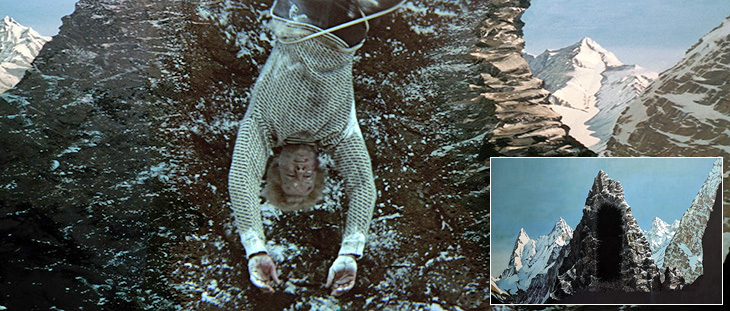 |
|
ABOVE: Cliff
Culley's matte painting seen in On Her Majesty's Secret
Service (1969) [inset] The original uncropped painting. As
the film was shot with Anamorphic lenses. which squeezed the
image horizontally, Cliff had to paint his artwork on glass
already squeezed, so that when the film was projected the final
composited image would appear in the same aspect ratio as the
live action filmed on set with Bernard Horsfall as Campbell.
|
|
|
|
There aren’t many
that would disagree with Cliff, but the Bondwagon rolled on with
Cliff as a happy passenger. The next stop was On Her Majesty’s
Secret Service. A new Bond and a new director in the guise of
Cliff’s old friend, Peter Hunt. Cliff was once again involved in the
mattes, which included an exterior shot of Piz Gloria, the mountain
behind the hanging body of Campbell, the casino reflection in the
hotel swimming pool (Where Bond is reacquainted with Tracy) and one
of the most admired sequences in the film, the avalanche. |
|

|
|
|
“It was a very
small set up,” Cliff remembers. “The trees weren’t that much more
than a foot and half tall and the snow was bags and bags of salt.”
Apparently the
whole model was set up on the small matte stage at Pinewood, that
was soon to become Cliff’s permanent base when he set up his own
special effects and optical company, Westbury Design and Optical in
the early Seventies at the studios.
He agrees that the
avalanche sequence worked very well and put it down to Peter Hunt’s
excellent editing technique. Reiterating Cliff’s admiration for the
man he felt was very important to the Bond films, I asked him what
was so special about working with Peter. |
|
|
 |
|
“It was a very
small set up,” Cliff remembers. “The trees weren’t that much more
than a foot and half tall and the snow was bags and bags of salt.”
Apparently the
whole model was set up on the small matte stage at Pinewood, that
was soon to become Cliff’s permanent base when he set up his own
special effects and optical company, Westbury Design and Optical in
the early Seventies at the studios.
He agrees that the
avalanche sequence worked very well and put it down to Peter Hunt’s
excellent editing technique. Reiterating Cliff’s admiration for the
man he felt was very important to the Bond films, I asked him what
was so special about working with Peter. |
|
|
|
|
“The beauty of it
was with Peter, if I had done a matte painting, I’d take it down to
show him. He would say ‘Fine, I’ll cut it in.’ He would then
cut that shot into the picture and in the evening when he showed the
rushes to Cubby he wouldn’t say a word; he’d just run the sequence.
Then at the end of it he’d say to Cubby, ‘What did you think of the
matte shot?’ Cubby would say, ‘What matte shot?’ Peter would
only then tell him where the matte shot was and Cubby would admit
that he hadn’t seen it on first viewing. Now some other directors
would put that matte on a loop piece of film and tear it to pieces.
Sometimes you would even get an art director who would say, ‘I
don’t really like that third brick from the top.’
Cliff rolls his eyes as he remembers
some of the over fastidious viewers of his paintings, but smiles
once again when he thinks of Peter Hunt.
I asked him if he
had any say in the mattes he created. “Oh yeah, you could input your
own ideas. The production doesn’t commission a matte unless they
know they want it in the picture. They’re not going to spend time
and money on a painting and see it left on the cutting room floor.
So by the time they’ve decided that they wanted a matte, I would
receive a sketch from the art director and then I’d be on my own
really. I’d liaise with Peter most of the times and yes, he would
let me put my ideas forward.”
Cliff goes onto say that he felt it
was a shame that Peter didn’t get to direct more Bonds. |
|
|
“He did some very
good stuff on that film an I thought, to be honest, that George Lazenby was pretty good as James Bond, but he was such an awkward
monkey. He just wouldn't play ball. So under the circumstances I
think Peter made a good job of directing. That scene at the end
where Bond’s wife is shot, he handled that quite brilliantly.” |
|
|
CONTINUED |
|

